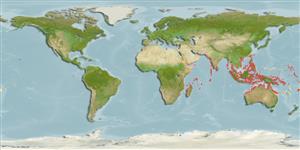Common names from other countries
>
Blenniiformes (Blennies) >
Blenniidae (Combtooth blennies) > Blenniinae
Etymology: Petroscirtes: Latin, petra, -ae = stone + Greek, skirteo = to jump.
Environment: milieu / climate zone / depth range / distribution range
Ecologia
marinhas associadas(os) a recifes; intervalo de profundidade 1 - 10 m (Ref. 86942). Tropical; 25°N - 24°S
Indo-West Pacific: Sri Lanka to Fiji, north to southern Taiwan and the Yaeyama Islands, south to the southern Great Barrier Reef.
Tamanho / Peso / Idade
Maturity: Lm ? range ? - ? cm
Max length : 15.0 cm TL macho/indeterminado; (Ref. 9710)
Descrição suscinta
Chaves de identificação | Morfologia | Morfometria
Espinhos dorsais (total) : 10 - 11; Raios dorsais (total) : 16 - 19; Espinhos anais: 2; Raios anais : 16 - 19. Sexually dimorphic: males are orange-brown while females are sea-green dorsally and lighter below. Similar to P. breviceps in shape but has a blotched, rather than lined pattern on the body. Some color form are probably habitat related. The plain form is mainly green and has numerous tiny pearly spots and occurs in seagrass beds (Ref. 48636).
Adults occur in seagrass beds of shallow lagoons. Also in Sargassum rafts during or immediately after wet season (Ref. 48636). Replaced by P. thepassi at Solomon Islands (Ref. 90102). They feed primarily on small crustaceans and occasionally on scales from fishes. Oviparous. Eggs are demersal and adhesive (Ref. 205), and are attached to the substrate via a filamentous, adhesive pad or pedestal (Ref. 94114). Larvae are planktonic, often found in shallow, coastal waters (Ref. 94114). This form was named by Bleeker (1852) as Petroscirtes bankanensis.
Ciclo de vida ou comportamento de acasalamento
Maturities | Reprodução | Spawnings | Egg(s) | Fecundities | Larvas
Oviparous, distinct pairing (Ref. 205).
Myers, R.F., 1991. Micronesian reef fishes. Second Ed. Coral Graphics, Barrigada, Guam. 298 p. (Ref. 1602)
Status na Lista Vermelha da UICN (Ref. 130435)
CITES (Ref. 128078)
Not Evaluated
Ameaça para os humanos
Harmless
Uso pelos humanos
Ferramentas
Relatórios especiais
Baixar XML
Fontes da internet
Estimates based on models
Preferred temperature (Ref.
115969): 26 - 29.3, mean 28.6 (based on 2654 cells).
Índice de diversidade filogenética (Ref.
82804): PD
50 = 0.5005 [Uniqueness, from 0.5 = low to 2.0 = high].
Bayesian length-weight: a=0.00562 (0.00258 - 0.01228), b=3.06 (2.87 - 3.25), in cm Total Length, based on LWR estimates for this (Sub)family-body shape (Ref.
93245).
Nível Trófico (Ref.
69278): 3.1 ±0.43 se; based on food items.
Resiliência (Ref.
120179): Elevada, tempo mínimo de duplicação da população menor que 15 meses (Preliminary K or Fecundity.).
Fishing Vulnerability (Ref.
59153): Low vulnerability (10 of 100).
